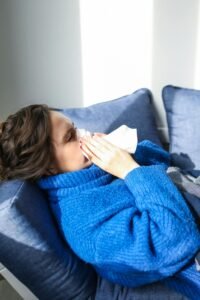1. Explanation About Sinus Infections

Sinus infection symptoms
Contents ↓
- Symptoms
- Infection and Reasons
- Infection Symptoms
- Diagnosis and Treatment
- Home Remedies
- Prevention
Symptoms of sinus infection can vary depending on the severity and cause but generally include:
- Dryness of the mouth Pain
- Facial pain or pressure
- Excessive runny nose
- Postnasal discharge
- Cough
- Fatigue
- Headache
- Fever
- Decreased sense of smell and taste
Sinus infections:
Sinus is as well known as sinusitis, are a common disease affecting
millions of people worldwide. Understanding the causes, symptoms
and treatment options of sinus infection is important to manage this
often unpleasant and sometimes debilitating condition.
Reasons:
Sinus Infection Symptoms occurs after the mucous membrane
lining the sinuses becomes inflamed along with swollen, causing
mucus to become blocked and trapped. Many factors can contribute
to sinusitis, which includes viral infections something like the common
cold, viral infections, allergies, nasal congestion together with structural
issues like a deviated septum( that divides the nose in to 2 chambers).
2. What Are Sinus Infection Symptoms?

A. Acute vs. Chronic Symptoms:
Acute sinusitis is normally short-lived, routinely less relative four weeks,
along caused by a viral infection like as the common cold.
Symptoms of acute sinusitis may include:
Nasal Congestion:
Difficulty breathing through the nose caused by inflammation of the nasal passages.
Thick nasal discharge:
Yellow or green discharge from the nose.
Pain or pressure in the mouth:
Numbness or tingling around the cheeks, eyes, forehead, or nose.
Loss of smell:
Decreased or faint smell.
Cough:
Usually worse at night or in bed.
Fatigue:
Feeling tired as a choice exhausted caused by the immune system.
Fever:
A low-grade fever may occur with acute sinusitis, mostly with viruses.
Sore teeth:
Frequently the upper teeth have pain, known as occlusal pain, that is a
result of the gums being under pressure .This symptoms can be mild in
some individuals initially but they end up affecting daily activities as
time goes by.
B. Chronic sinusitis:
Chronic sinusitis is diagnosed when the symptoms last for more than 12 weeks
nevertheless of treatment attempts. In interpreting the sentence, the phrase
‘despite treatment efforts’ refers to all attempts made to the alleviation of
chronic sinusitis.
conclusion:
It is important to distinguish between the symptoms of acute and chronic sinusitis for acute diagnosis and appropriate treatment.
While acute sinusitis usually resolves within a few weeks with proper management, long-term management may be needed to
control symptoms and control the underlying cause deal with If you experience persistent or severe symptoms of sinusitis,
it is important to consult with a health care professional for correct diagnosis and treatment.
3. Diagnosis and Treatment Options:
Research conducted:
The detection of sinusitis is a product of the mix of medical history review,
physical evaluation, and some time diagnostic tests.
The main steps in the research process are:
Medical History:
The health professional, whom is the qualified health worker, will ask
about the patient’s symptoms, specifying the appearance of the symptoms,
their duration, level of severity, and any circumstances, that might increase
those symptoms mitigating factors. Medical history in the past will be analysed
as well, such as any abscesses, sinus infections or long lasting disease that are
presented in that patient’s records conditions.
Physical Examination:
The physical examination includes examination of the nasal cavity, sinuses,
and throat, for the signs of inflammation redness swelling (or whatever).
diagnosis The process, by gently pressing on the patient’s nose to see
whether he or she is suffering from pain or tenderness, is known as nasal exam.
Nasal endoscopy:
Occasionally, a nasal endoscopy is required for the purpose of examining
the nasal passages and nostrils very closely. This procedure involves inserting
a thin, narrow tube with a bronchoscopy camera into the nose is diagnostic
of sinus problem.
Imaging Studies:
Imaging tests e. g. sinus x-raying, CT scanning or the usual MRI scanning
will be ordered to get more detailed images of the sinus and help for
determine the locations of distortions, knots or strangulations together
with any related complications to the patients.
Screening:
If it is proven that sinusitis is the main reason for which sinusitis is
occurring, testing for sinusitis might be suggested. Diagnostic tests like
nasal endoscopy, imaging studies (such as CT or MRI scans), and allergy testing
these screenings help identify underlying causes, severity, and appropriate
treatment options for individuals experiencing sinus issues.
4.Treatment Options:
reducing inflammation and getting the nasal sinuses into their normal conditions.
eliminate the cause. If more appropriate medication is used, the effectiveness
their severity, their duration and the cause of the sinusitis.
Common treatments include
Oral Corticosteroids:
The effective treatment of bacterial sinusitis is realized through the use of
antibiotics in order to get rid of the bacterial infection. However, mandatory
arrest is not the only and all options that are existing in this sphere.
Allergy management:
therefore many allergy coping methods, such as allergen avoidance, ergo,
antihistamine or therapy with allergen injections (allergy shots) might be
recommended to you.
Surgery:
In this case, as chronic or often occurring sinusitis which does not get
better with other treatments a surgery will be required. Surgical there are
choices that may include functional endoscopic sinus surgery (FESS)
to remove mucosa, address bone obstruction, and to enlarge sinus
openings or sinus passages.
5. Home Remedies for Sinus Infections:
Nasal Irrigation:
Nasal irrigation is one of the most effective home remedies people
suffering from nasal congestion, sinus pressure, and symptoms or
seek relief from headaches and other allergy symptoms use of sinusitis,
allergies, or the common cold. Air pollution whether from industrial emissions,
vehicle fumes, or even wildfire smoke can lead to respiratory diseases such
as sinusitis, allergies It could in this way facilitate the moistening of nasal
passages.
Steam Inhalation:
The process of steam inhalation covers the nasal passages, voice-box
going down the lungs, hence moistening and loosening mucus in
this course, thus making it easier to cough out. congestion alleviate
discomfort.
Warm Compress:
Using a warm compress may in such manner be the soothing and effective
way of cheeking symptoms caused by sinusitis or sinus congestion.
Heat makes discomfort ease; helps reduce inflammation; and
improve the removal of mucus.
Hydration and Rest:
Tips for Hydration and Rest:
1. Drink enough water often daily, the total quantity should at least not under
8-10 glasses per day. But tea from herbs and broth with electrolyte drink can
also be used, for it is good.
2. Take care to avoid highly caffeinated beverages and alcohol as they cause dehydration.
3.Inadequate or poor sleep quality has been associated with weight gain and obesity.
sleep each night, aiming for 7-9 hours for adults.
4. Apply relaxation skills such as deep breathing, meditation or gentle yoga
as those can help you cope with the stress and provide rest.
5. Air humidifiers may be used in your bedroom to make the air moist,
which, in a way, can help reduce irritated nasal passages and improve
the symptoms of the sinuses.
Herbal Remedies:
Eucalyptus oil −Peppermint oil −Ginger −Garlic −Turmeric
6. Preventive tips for sinus infections
Maintaining Good Nasal Hygiene:
Regular nasal hygiene is very vital in ensuring that your nasal parts are clean
and healthy by facilitating a smooth nasal flow that, consequently, reduces
chances of sinusitis, allergies and other respiratory conditions.
Here are some tips for maintaining good nasal hygiene:
1. To Mitigate Spread of Infection, Keep Your Hands Clean, and Live in a Splosh Like Place.
2. Improper use of Nasal Decongestant Sprays and Nasal Breathing instead of Mouth.
3. Breathing due to asthma caused the increased retention of carbon dioxide (CO2)
as the CO2 was exhaled through the mouth rather than through the nose.
Avoiding Allergens and Irritants:
Seek Treatment for Allergies and Sinus Infections:
If you are affected with allergies or sinus infections, visit a healthcare facility
and see a professional for proper treatment. Antiallergic drugs, immunotherapy
(allergy injections), and nasal inhalers also assist in controlling the symptoms and
enhancing the health of nasal cavities.
Boosting Immunity:
Here are some strategies for boosting immunity to support sinus health:
- Eat a Healthy Diet Stay
- Hydrated Manage Stress
- Practice Good Hygiene
- Consider Immune-Boosting Supplements
https://absoluteinformation.com/migraines-home-remedies-without-medication/


1 thought on “Sinus Infection Symptoms”